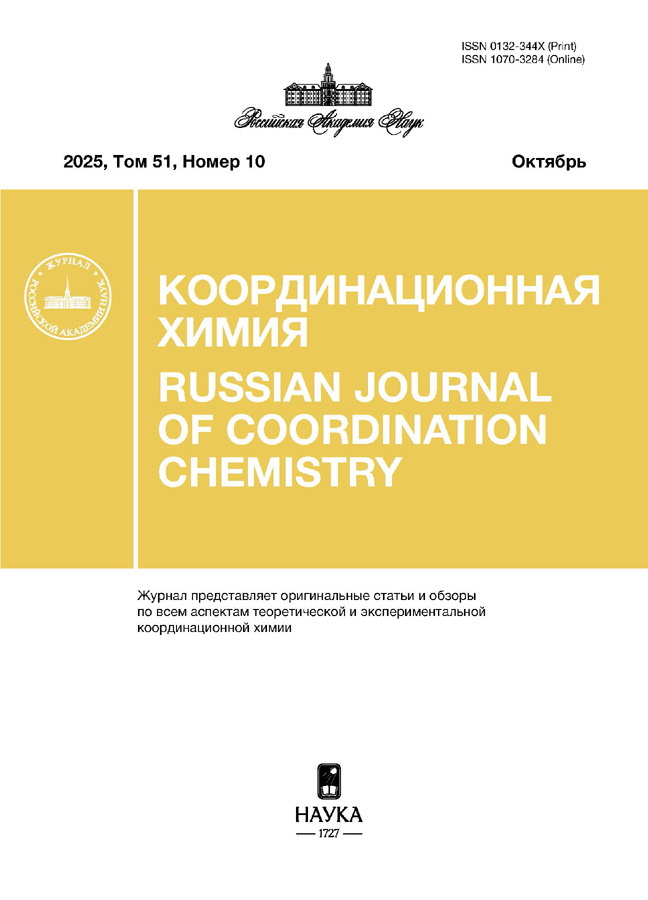Synthesis of neutral binuclear two-chain helicate from the anionic Fe(III) complex of 5-chlorosalicylaldehyde thiosemicarbazone by electrocrystallization
- Authors: Spitsyna N.G.1, Blagov M.A.1, Lobach A.S.1, Manzhos R.A.1, Krivenko A.G.1, Lazarenko V.A.2, Zorina L.V.3, Simonov S.V.3
-
Affiliations:
- Federal Research Center of Problems of Chemical Physics and Medicinal Chemistry, Russian Academy of Sciences
- National Research Center Kurchatov Institute
- Osipyan Institute of Solid State Physics, Russian Academy of Sciences
- Issue: Vol 51, No 4 (2025)
- Pages: 265-276
- Section: Articles
- URL: https://gynecology.orscience.ru/0132-344X/article/view/679431
- DOI: https://doi.org/10.31857/S0132344X25040068
- EDN: https://elibrary.ru/LPCBLG
- ID: 679431
Cite item
Abstract
The electrocrystallization of salts of the anionic spin-variable complex [FeIII(L)2]‒ (L is 5-chlorosalicylaldehyde thiosemicarbazone (Н25Cl-thsa)) with cations Cat+ = K+ (I), Me4N+ (II), and Et4N+ (III) affords crystals of the neutral binuclear two-chain helicate [FeIII2(L1)2]0 (IV) (L1 = (L‒2)‒(L‒) are transformed monoanionic and dianionic fragments of L, respectively, linked with each other by the disulfide S–S bridge), which are identified by XRD at 100 and 293 K as the same phase IV · n(H2O) (n ≤ 6) with close lattice parameters. “Fresh” crystals of the complex obtained from salt I correspond to the composition IV · 6(H2O) at 293 K, rapidly lose 50% water molecules, and decrepitate to fine crystalline fragments IV · 3(H2O). The structure of crystals IV · 6(H2O) is monoclinic (space group С2/c) and characterized by cavities filled with disordered water molecules, which amount to more than 20% of the total unit cell volume. Complex IV has the point symmetry group С2 and high-spin geometry of coordination nodes N4O2. As found by cyclic voltammetry, electrochemically inactive complex IV is formed by the two-electron oxidation of the [FeIII(5Cl-thsa)2]– anion via the EEC mechanism.
Full Text
About the authors
N. G. Spitsyna
Federal Research Center of Problems of Chemical Physics and Medicinal Chemistry, Russian Academy of Sciences
Author for correspondence.
Email: spitsina@icp.ac.ru
Russian Federation, Chernogolovka, Moscow oblast
M. A. Blagov
Federal Research Center of Problems of Chemical Physics and Medicinal Chemistry, Russian Academy of Sciences
Email: spitsina@icp.ac.ru
Russian Federation, Chernogolovka, Moscow oblast
A. S. Lobach
Federal Research Center of Problems of Chemical Physics and Medicinal Chemistry, Russian Academy of Sciences
Email: spitsina@icp.ac.ru
Russian Federation, Chernogolovka, Moscow oblast
R. A. Manzhos
Federal Research Center of Problems of Chemical Physics and Medicinal Chemistry, Russian Academy of Sciences
Email: spitsina@icp.ac.ru
Russian Federation, Chernogolovka, Moscow oblast
A. G. Krivenko
Federal Research Center of Problems of Chemical Physics and Medicinal Chemistry, Russian Academy of Sciences
Email: spitsina@icp.ac.ru
Russian Federation, Chernogolovka, Moscow oblast
V. A. Lazarenko
National Research Center Kurchatov Institute
Email: spitsina@icp.ac.ru
Russian Federation, Moscow
L. V. Zorina
Osipyan Institute of Solid State Physics, Russian Academy of Sciences
Email: spitsina@icp.ac.ru
Russian Federation, Chernogolovka, Moscow oblast
S. V. Simonov
Osipyan Institute of Solid State Physics, Russian Academy of Sciences
Email: spitsina@icp.ac.ru
Russian Federation, Chernogolovka, Moscow oblast
References
- van Koningsbruggen P.J., Maeda Y., Oshio H. // Top. Curr. Chem. 2004. V. 233. P. 259.
- Li Z.-Y., Dai J.-W., Shiota Y. et al. // Chem. Eur. J. 2013. V. 19. № 39. P. 12948.
- Jeong H., Kang Y., Kim J. // RSC Adv. 2019. V. 9. № 16. P. 9049.
- Heffetera P., Pape V. F.S., Enyedy E.A. et al. // Antioxidants & Redox Signaling. 2019. V. 30. № 8. P. 1.
- Chang T.M., Tomat E. // Dalton Trans. 2013. V. 42. № 22. P. 7846.
- Pedrido R., Romero M.J., Bermejo M.R. et al. // Chem. Eur. J. 2008. V. 14. № 2. P. 500.
- Leovac V. M., Bjelica L., Jovanović L. // Polyhedron. 1985. V. 4. P. 233.
- Kaya B., Kaya K., Koca A. et al. // Polyhedron. 2019. V. 173. P. 114130.
- Blagov M., Spitsyna N., Lazarenko V. et al. // Eur. J. Inorg. Chem. 2023. V. 26. № 23. P. e202300239.
- Cambridge Structural Database System. Version 3.0, 2021. https://www.ccdc.cam.ac.uk/
- Fujinami T., Nishi K., Kitashima R. et al. // Inorg. Chim. Acta. 2011. V. 376. P. 136.
- CrysAlisPro. Version 1.171.38. Rigaku Oxford Diffraction, 2015.
- Svetogorov R.D., Dorovatovskii P.V., Lazarenko V.A. // Cryst. Res. Technol. 2020. V. 55. P. 1900184.
- Kabsch W. // Acta Crystallogr. D. 2010. V. 66. P. 125.
- Sheldrick G.M. // Acta Crystallogr. A. 2008. V. 64. P. 112.
- Sheldrick G.M. // Acta Crystallogr. C. 2015. V. 71. P. 3.
- Spek A.L. // Acta Crystallogr. C. 2015. V. 71. P. 9.
- Зеленцов В.В., Аблов А.В., Турта К.И. и др. // Журн. неорган. хим. 1972. Т. 17. № 7. С. 1929.
- Spitsyna N.G., Blagov M.A., Lazarenko V.A. et al. // Inorg. Chem. 2021. V. 60. № 23. P. 17462.
- Krivenko A. G., Manzhos R. A., Kochergin V. K. // Russ. J. Electrochem. 2019. V. 55. № 7. P. 663.
Supplementary files















